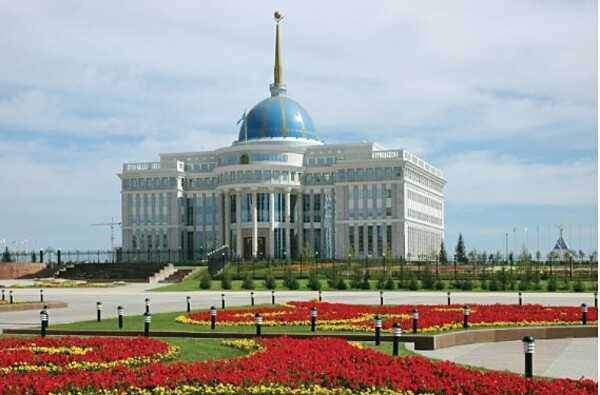Kazakhstan - KZ - KAZ - KAZ - Central Asia
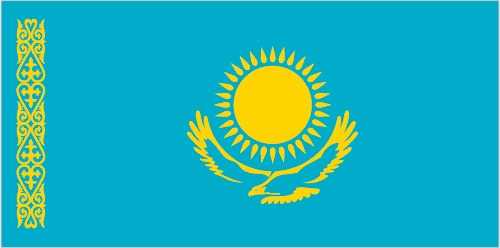
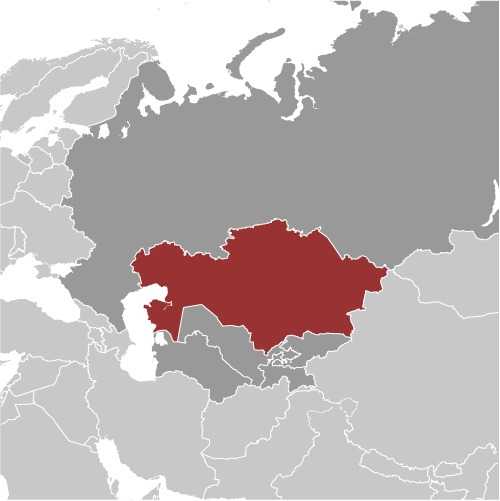
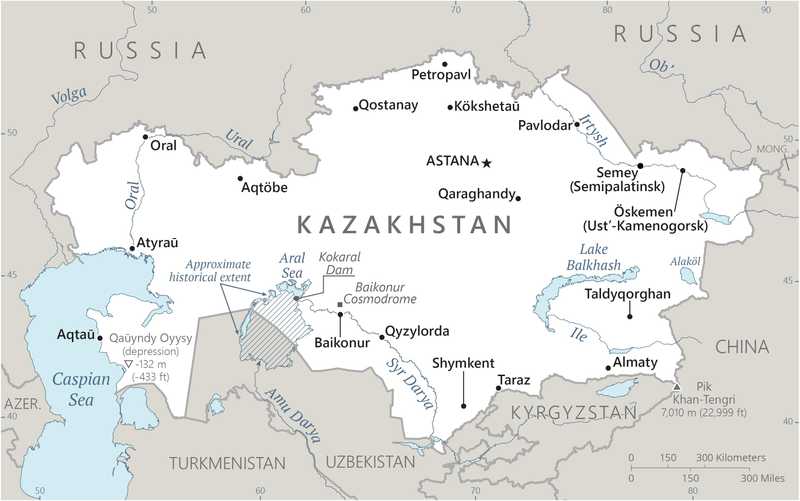
Kazakhstan Images
Kazakhstan Factbook Data
Age structure
15-64 years: 62.8% (male 6,233,881/female 6,486,019)
65 years and over: 9.6% (2024 est.) (male 700,091/female 1,244,043)
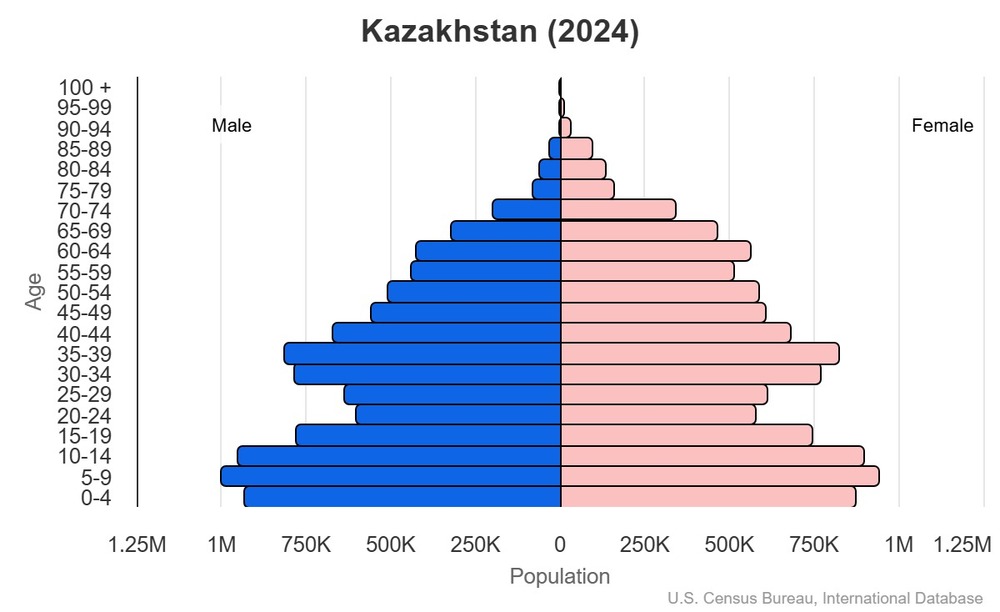
For additional information, please see the entry for Population pyramid on the Definitions and Notes page.
Geographic coordinates
Sex ratio
0-14 years: 1.06 male(s)/female
15-64 years: 0.96 male(s)/female
65 years and over: 0.56 male(s)/female
total population: 0.94 male(s)/female (2024 est.)
Natural hazards
Area - comparative
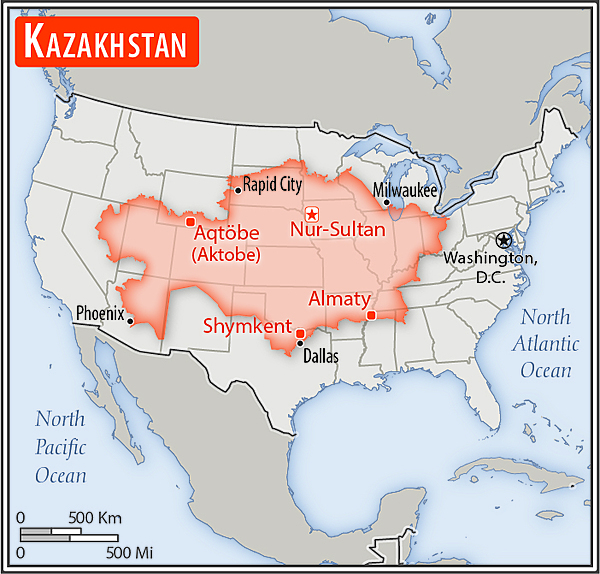
slightly less than four times the size of Texas
Military service age and obligation
note: as of 2022, more than 10,000 women served in the Armed Forces and the National Guard
Background
Ethnic Kazakhs derive from a mix of Turkic nomadic tribes that migrated to the region in the 15th century. The Russian Empire conquered the Kazakh steppe in the 18th and 19th centuries, and Kazakhstan became a Soviet Republic in 1925. Forced agricultural collectivization led to repression and starvation, resulting in more than a million deaths in the early 1930s. During the 1950s and 1960s, the agricultural "Virgin Lands" program generated an influx of settlers -- mostly ethnic Russians, but also other nationalities -- and by the time of Kazakhstan’s independence in 1991, ethnic Kazakhs were a minority. However, non-Muslim ethnic minorities departed Kazakhstan in large numbers from the mid-1990s through the mid-2000s, and a national program has repatriated about a million ethnic Kazakhs (from Uzbekistan, Tajikistan, Mongolia, and the Xinjiang region of China) to Kazakhstan. As a result of this shift, the ethnic Kazakh share of the population now exceeds two-thirds.
Kazakhstan's economy is the largest in Central Asia, mainly due to the country's vast natural resources. Current issues include diversifying the economy, attracting foreign direct investment, enhancing Kazakhstan's economic competitiveness, and strengthening economic relations with neighboring states and foreign powers.
Environmental issues
International environmental agreements
signed, but not ratified: none of the selected agreements
Military expenditures
1% of GDP (2023 est.)
0.9% of GDP (2022 est.)
1% of GDP (2021 est.)
1.1% of GDP (2020 est.)
Population below poverty line
note: % of population with income below national poverty line
Household income or consumption by percentage share
highest 10%: 24.8% (2021 est.)
note: % share of income accruing to lowest and highest 10% of population
Exports - commodities
note: top five export commodities based on value in dollars
Exports - partners
note: top five export partners based on percentage share of exports
Administrative divisions
note 1: administrative divisions have the same names as their administrative centers; exceptions show the administrative center name in parentheses
note 2: in 1995, the Kazakh and Russian governments agreed that Russia would lease for 20 years an area of 6,000 sq km (2,317 sq mi) around the Baikonur space launch facilities and the city of Bayqongyr (Baikonur, formerly Leninsk); in 2004, the lease was extended to 2050
Agricultural products
note: top ten agricultural products based on tonnage
Military and security forces
Ministry of Internal Affairs: National Police, National Guard
Committee for National Security (KNB): Border Guard Service (2025)
note: the National Guard is a gendarmerie type force administered by the Ministry of Internal Affairs, but also serves the Ministry of Defense; it is responsible for fighting crime, maintaining public order, and ensuring public safety; other duties include anti-terrorism operations, guarding prisons, riot control, and territorial defense in time of war
Budget
expenditures: $47.247 billion (2023 est.)
note: central government revenues (excluding grants) and expenditures converted to US dollars at average official exchange rate for year indicated
Capital
geographic coordinates: 51 10 N, 71 25 E
time difference: UTC+5 (10 hours ahead of Washington, DC, during Standard Time)
time zone note: On 1 March 2024, Kazakhstan moved from using two time zones to one
etymology: the name means "capital city" in Kazakh
note: founded in 1830 as Akmoly, the capital city became Akmolinsk in 1832, Tselinograd in 1961, Akmola (Aqmola) in 1992, Astana in 1998, and Nur-Sultan in 2019; the latest name change back to Astana in 2022 occurred just three and a half years after the city was renamed to honor a former president, who subsequently fell out of favor
Imports - commodities
note: top five import commodities based on value in dollars
Climate
Coastline
note: Kazakhstan borders the Aral Sea, now split into two bodies of water (1,070 km), and the Caspian Sea (1,894 km)
Constitution
amendment process: introduced by a referendum initiated by the president of the republic, on the recommendation of Parliament, or by the government; the president has the option of submitting draft amendments to Parliament or directly to a referendum; passage of amendments by Parliament requires four-fifths majority vote of both houses and the signature of the president; passage by referendum requires absolute majority vote by more than one half of the voters in at least two thirds of the oblasts, major cities, and the capital, followed by the signature of the president
Exchange rates
Exchange rates:
468.962 (2024 est.)
456.165 (2023 est.)
460.165 (2022 est.)
425.908 (2021 est.)
412.953 (2020 est.)
Executive branch
head of government: Prime Minister Olzhas BEKTENOV (since 6 February 2024)
cabinet: the president appoints ministers based on the prime minister's recommendations; the president has veto power over all appointments and independently appoints the ministers of defense, internal affairs, and foreign affairs
election/appointment process: president directly elected by simple-majority popular vote for a single 7-year term (prior to September 2022, the president of Kazakhstan could serve up to two 5-year terms; legislation reduced it to one 7-year term); prime minister and deputy prime ministers appointed by the president, approved by the Mazhilis
most recent election date: 20 November 2022
election results:
2024: Olzhas BEKTENOV elected as prime minister; 69-0 in parliament
2022: Kasym-Zhomart TOKAYEV reelected president; percent of vote - Kassym-Jomart TOKAYEV (Amanat) 81.3%, Zhiguli DAYRABAEV (Auyl) 3.4%, Qaraqat or Karakat ÄBDEN (KÄQŪA) 2.6%, Meyram KAZHYKEN (Amanat) 2.5%, Nurlan AUYESBAYEV (NSDP) 2.2%, Saltanat TURSYNBEKOVA (QA-DJ) 2.1%, other 5.8%
2019: Kasym-Zhomart TOKAYEV elected president; percent of vote - Kasym-Zhomart TOKAYEV (Amanat) 71%, Amirzhan KOSANOV (Ult Tagdyry) 16.2%, Daniya YESPAYEVA (Ak Zhol) 5.1%, other 7.7%
expected date of next election: 2029
Flag
meaning: the blue color has religious significance for the Turkic peoples and symbolizes cultural and ethnic unity, as well as sky and water; the sun stands for wealth and plenitude, with rays shaped like grain; the eagle has appeared on Kazakh tribal flags for centuries and represents freedom, power, and the flight to the future
Independence
Industries
Judicial branch
judge selection and term of office: Supreme Court judges proposed by the president of the republic on recommendation of the Supreme Judicial Council and confirmed by the Senate; judges normally serve until age 65 but can be extended to age 70; Constitutional Council - the president of the republic, the Senate chairperson, and the Mazhilis chairperson each appoints 2 members for a 6-year term; chairperson of the Constitutional Council appointed by the president for a 6-year term
subordinate courts: regional and local courts
Land boundaries
border countries (5): China 1,765 km; Kyrgyzstan 1,212 km; Russia 7,644 km; Turkmenistan 413 km; Uzbekistan 2,330 km
Legal system
Legislative branch
legislative structure: bicameral
Maritime claims
International organization participation
National holiday
Nationality
adjective: Kazakhstani
Natural resources
Geography - note
Economic overview
Railways
broad gauge: 16,636 km (2021) 1.520-m gauge (4,237 km electrified)
Suffrage
Terrain
Government type
Country name
conventional short form: Kazakhstan
local long form: Qazaqstan Respublikasy
local short form: Qazaqstan
former: Kazakh Soviet Socialist Republic
etymology: the name may derive from the Turkic word kazak, meaning "nomad;" the Persian suffix -stan means "place of" or "country"
Location
Map references
Irrigated land
Diplomatic representation in the US
chancery: 1401 16th Street NW, Washington, DC 20036
telephone: [1] (202) 232-5488
FAX: [1] (202) 232-5845
email address and website:
washington@mfa.kz
https://www.gov.kz/memleket/entities/mfa-washington?lang=en
consulate(s) general: New York, San Francisco
Internet users
Internet country code
Refugees and internally displaced persons
IDPs: 0 (2024 est.)
stateless persons: 7,865 (2024 est.)
GDP (official exchange rate)
note: data in current dollars at official exchange rate
Total renewable water resources
School life expectancy (primary to tertiary education)
male: 14 years (2024 est.)
female: 14 years (2024 est.)
Urbanization
rate of urbanization: 1.19% annual rate of change (2020-25 est.)
Broadcast media
Drinking water source
urban: 98% of population (2022 est.)
unimproved:
urban: 2% of population (2022 est.)
National anthem(s)
lyrics/music: Zhumeken NAZHIMEDENOV and Nursultan NAZARBAYEV/Shamshi KALDAYAKOV
history: adopted 2006; President Nursultan NAZARBAYEV played a role in revising the lyrics
Major urban areas - population
International law organization participation
Physician density
Hospital bed density
National symbol(s)
Mother's mean age at first birth
GDP - composition, by end use
government consumption: 11.1% (2023 est.)
investment in fixed capital: 26.5% (2023 est.)
investment in inventories: 3.3% (2023 est.)
exports of goods and services: 34.5% (2023 est.)
imports of goods and services: -27.5% (2023 est.)
note: figures may not total 100% due to rounding or gaps in data collection
Dependency ratios
youth dependency ratio: 44 (2024 est.)
elderly dependency ratio: 15.3 (2024 est.)
potential support ratio: 6.5 (2024 est.)
Citizenship
citizenship by descent only: at least one parent must be a citizen of Kazakhstan
dual citizenship recognized: no
residency requirement for naturalization: 5 years
Population distribution
Electricity access
Civil aircraft registration country code prefix
Sanitation facility access
urban: 99.9% of population (2022 est.)
rural: 99.9% of population (2022 est.)
total: 99.9% of population (2022 est.)
unimproved:
urban: 0.1% of population (2022 est.)
rural: 0.1% of population (2022 est.)
total: 0.1% of population (2022 est.)
Ethnic groups
Religions
Languages
major-language sample(s):
Әлемдік деректер кітабы, негізгі ақпараттың таптырмайтын көзі. (Kazakh)
Книга фактов о мире – незаменимый источник базовой информации. (Russian)
The World Factbook, the indispensable source for basic information.
note: percentages are based on population that understands the spoken language
Imports - partners
note: top five import partners based on percentage share of imports
Elevation
note - the northern most 7,000 meter peak in the World
lowest point: Qauyndy Oyysy -132 m
mean elevation: 387 m
Health expenditure
10.6% of national budget (2022 est.)
Military - note
Kazakhstan has been a member of the Collective Security Treaty Organization (CSTO) since 1994 and has obligated troops to CSTO's rapid reaction force; it also has had a relationship with NATO since 1992 focused on democratic, institutional, and defense reforms (2025)
Military and security service personnel strengths
Military equipment inventories and acquisitions
Total water withdrawal
industrial: 5.995 billion cubic meters (2022)
agricultural: 14.264 billion cubic meters (2022)
Waste and recycling
percent of municipal solid waste recycled: 3.8% (2022 est.)
Average household expenditures
on alcohol and tobacco: 2.2% of household expenditures (2023 est.)
Major watersheds (area sq km)
Major lakes (area sq km)
salt water lake(s): Caspian Sea (shared with Iran, Azerbaijan, Turkmenistan, and Russia) - 374,000 sq km; Aral Sea (north) - 3,300 sq km; Ozero Alakol - 2,650 sq km; Ozero Teniz 1,590 sq km; Ozero Seletytenzi - 780 sq km; Ozero Sasykkol - 740 sq km
Major rivers (by length in km)
note: [s] after country name indicates river source; [m] after country name indicates river mouth
National heritage
selected World Heritage Site locales: Mausoleum of Khoja Ahmed Yasawi (c); Petroglyphs at Tanbaly (c); Saryarka - Steppe and Lakes of Northern Kazakhstan (n); Silk Roads: the Chang'an-Tianshan Corridor (c); Western Tien-Shan (n); Cold Winter Deserts of Turan (n)
Coal
consumption: 86.349 million metric tons (2023 est.)
exports: 34.043 million metric tons (2023 est.)
imports: 114,000 metric tons (2023 est.)
proven reserves: 25.605 billion metric tons (2023 est.)
Electricity generation sources
solar: 1.9% of total installed capacity (2023 est.)
wind: 2.1% of total installed capacity (2023 est.)
hydroelectricity: 8.2% of total installed capacity (2023 est.)
Natural gas
consumption: 22.223 billion cubic meters (2023 est.)
exports: 7.071 billion cubic meters (2023 est.)
imports: 408.952 million cubic meters (2023 est.)
proven reserves: 2.407 trillion cubic meters (2021 est.)
Petroleum
refined petroleum consumption: 386,000 bbl/day (2023 est.)
crude oil estimated reserves: 30 billion barrels (2021 est.)
Gross reproduction rate
Remittances
0.1% of GDP (2023 est.)
0.2% of GDP (2022 est.)
note: personal transfers and compensation between resident and non-resident individuals/households/entities
Nuclear energy
Space launch site(s)
note 1: Baikonur Cosmodrome is leased and administered by Russia until 2050; the cosmodrome was originally built by the Soviet Union in the mid-1950s and is the site of the World's first successful satellite launch (Sputnik) in 1957; it is also the largest space launch facility in the World
note 2: in 2018, Kazakhstan and Russia agreed that Kazakhstan would build, maintain, and operate a new space launch facility (Baiterek) at the Baikonur Space Center (estimated to be fully operational in 2027-2028)
Space agency/agencies
Legislative branch - lower chamber
number of seats: 98 (all directly elected)
electoral system: mixed system
scope of elections: full renewal
term in office: 5 years
most recent election date: 3/19/2023
parties elected and seats per party: Amanat party (62); Auyl party (8); Ak Zhol Democratic Party of Kazakhstan (6); Respublica (6); People's Party of Kazakhstan (5); Independents (7); Other (4)
percentage of women in chamber: 18.4%
expected date of next election: March 2028
Legislative branch - upper chamber
number of seats: 50 (40 indirectly elected; 10 appointed)
scope of elections: partial renewal
term in office: 6 years
most recent election date: 1/14/2023
percentage of women in chamber: 20%
expected date of next election: January 2026
Child marriage
women married by age 18: 7% (2015)
National color(s)
National coat of arms

Particulate matter emissions
Methane emissions
agriculture: 781.2 kt (2019-2021 est.)
waste: 184.1 kt (2019-2021 est.)
other: 17.7 kt (2019-2021 est.)
Labor force
note: number of people ages 15 or older who are employed or seeking work
Youth unemployment rate (ages 15-24)
male: 3% (2024 est.)
female: 4.8% (2024 est.)
note: % of labor force ages 15-24 seeking employment
Net migration rate
Median age
male: 30 years
female: 33.8 years
Debt - external
note: present value of external debt in current US dollars
Maternal mortality ratio
Reserves of foreign exchange and gold
$35.965 billion (2023 est.)
$35.076 billion (2022 est.)
note: holdings of gold (year-end prices)/foreign exchange/special drawing rights in current dollars
Public debt
note: central government debt as a % of GDP
Total fertility rate
Unemployment rate
4.9% (2023 est.)
4.9% (2022 est.)
note: % of labor force seeking employment
Population
male: 9,817,172
female: 10,442,834
Carbon dioxide emissions
from coal and metallurgical coke: 175.848 million metric tonnes of CO2 (2023 est.)
from petroleum and other liquids: 50.387 million metric tonnes of CO2 (2023 est.)
from consumed natural gas: 43.596 million metric tonnes of CO2 (2023 est.)
Area
land: 2,699,700 sq km
water: 25,200 sq km
Taxes and other revenues
note: central government tax revenue as a % of GDP
Real GDP (purchasing power parity)
$705.52 billion (2023 est.)
$671.285 billion (2022 est.)
note: data in 2021 dollars
Airports
Infant mortality rate
male: 8.9 deaths/1,000 live births
female: 7 deaths/1,000 live births
Telephones - mobile cellular
subscriptions per 100 inhabitants: 130 (2022 est.)
Gini Index coefficient - distribution of family income
note: index (0-100) of income distribution; higher values represent greater inequality
Inflation rate (consumer prices)
14.7% (2023 est.)
15% (2022 est.)
note: annual % change based on consumer prices
Current account balance
-$9.448 billion (2023 est.)
$6.436 billion (2022 est.)
note: balance of payments - net trade and primary/secondary income in current dollars
Real GDP per capita
$34,700 (2023 est.)
$33,500 (2022 est.)
note: data in 2021 dollars
Broadband - fixed subscriptions
subscriptions per 100 inhabitants: 18 (2023 est.)
Tobacco use
male: 35.7% (2025 est.)
female: 6.3% (2025 est.)
Obesity - adult prevalence rate
Energy consumption per capita
Death rate
Birth rate
Electricity
consumption: 106.201 billion kWh (2023 est.)
exports: 2.243 billion kWh (2023 est.)
imports: 3.694 billion kWh (2023 est.)
transmission/distribution losses: 9.439 billion kWh (2023 est.)
Merchant marine
by type: general cargo 3, oil tanker 7, other 112
Imports
$72.723 billion (2023 est.)
$60.439 billion (2022 est.)
note: balance of payments - imports of goods and services in current dollars
Exports
$90.926 billion (2023 est.)
$93.822 billion (2022 est.)
note: balance of payments - exports of goods and services in current dollars
Heliports
Telephones - fixed lines
subscriptions per 100 inhabitants: 13 (2023 est.)
Alcohol consumption per capita
beer: 2.52 liters of pure alcohol (2019 est.)
wine: 0.16 liters of pure alcohol (2019 est.)
spirits: 1.05 liters of pure alcohol (2019 est.)
other alcohols: 0 liters of pure alcohol (2019 est.)
Life expectancy at birth
male: 69 years
female: 77.9 years
Real GDP growth rate
5.1% (2023 est.)
3.2% (2022 est.)
note: annual GDP % growth based on constant local currency
Industrial production growth rate
note: annual % change in industrial value added based on constant local currency
GDP - composition, by sector of origin
industry: 31.4% (2024 est.)
services: 58.2% (2024 est.)
note: figures may not total 100% due to non-allocated consumption not captured in sector-reported data
Population growth rate
Diplomatic representation from the US
embassy: Rakhymzhan Koshkarbayev Avenue, No. 3, Astana 010010
mailing address: 2230 Astana Place, Washington DC 20521-2230
telephone: [7] (7172) 70-21-00
FAX: [7] (7172) 54-09-14
email address and website:
USAKZ@state.gov
https://kz.usembassy.gov/
consulate(s) general: Almaty
Land use
arable land: 11% (2023 est.)
permanent crops: 0% (2023 est.)
permanent pasture: 68.3% (2023 est.)
forest: 1.3% (2023 est.)
other: 19.3% (2023 est.)
Space program overview
Political parties
Amanat formerly Nur Otan
Auyl People's Democratic Patriotic Party or Auyl
Green Party of Kazakhstan orBaytaq
Nationwide Social Democratic Party or NSDP
People's Party of Kazakhstan or PPK
Respublica
Currently married women (ages 15-49)
Key space-program milestones
2006 - first communications satellite (KazSat-1) built jointly with Italy and launched by Russia
2014 - first remote sensing satellite (KazEOSat-1) built by France and launched on European rocket
2024 - joined China-led lunar base project
Education expenditure
22% national budget (2024 est.)

